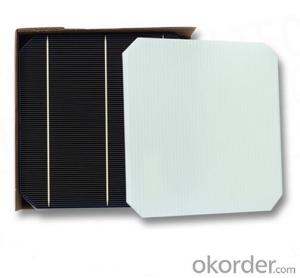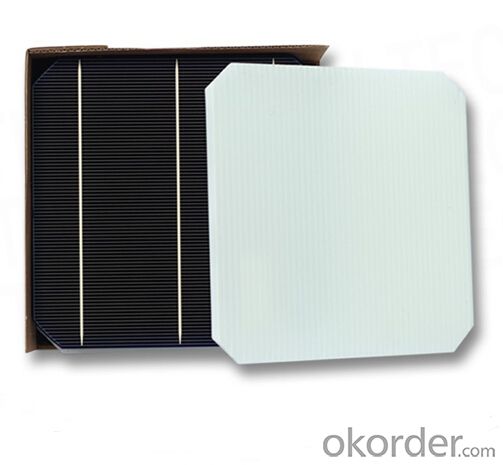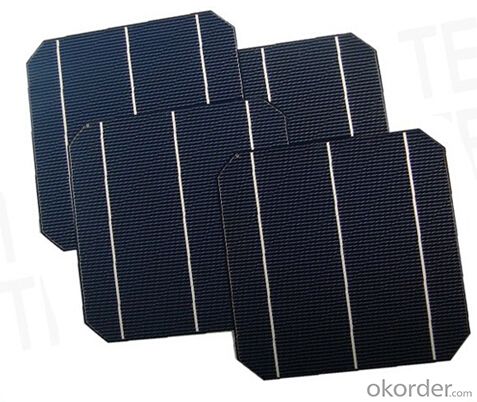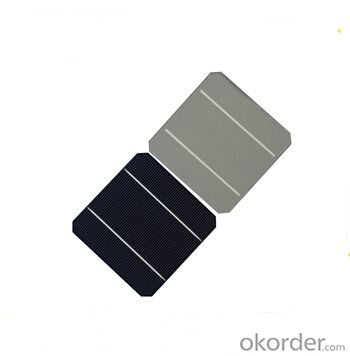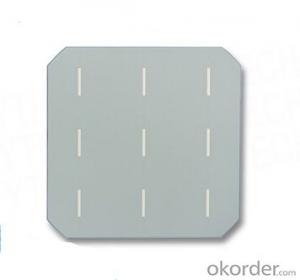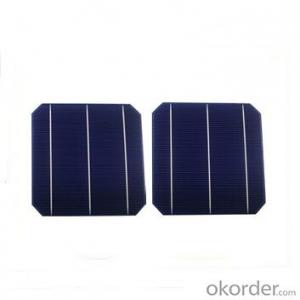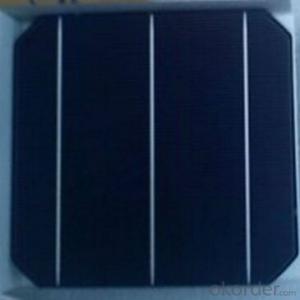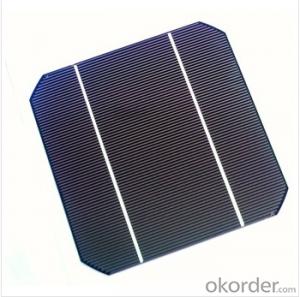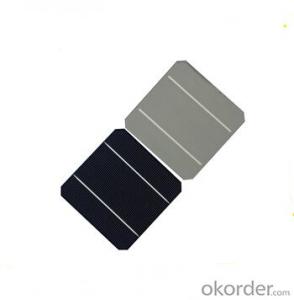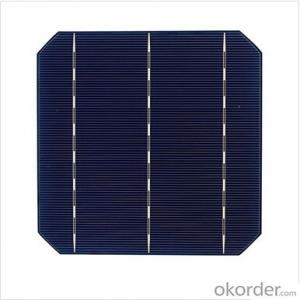Bio Solar Cells - Monocrystalline Solar Cells A Grade 18.2%
- Loading Port:
- Shanghai
- Payment Terms:
- TT OR LC
- Min Order Qty:
- 5000 pc
- Supply Capability:
- 800000 pc/month
OKorder Service Pledge
OKorder Financial Service
You Might Also Like
Brief Introduction of Solar Cells
A solar cell, is an electrical device that converts the energy of light directly into electricity by the photovoltaic effect, which is a physical and chemical phenomenon. It is a form of photoelectric cell, defined as a device whose electrical characteristics, such as current, voltage, or resistance, vary when exposed to light. Solar cells are the building blocks of photovoltaic modules, otherwise known as solar panels.
Advantage of Monocrystalline Solar Cells
1. Tire-1 Solar Cells’ Manufacturer Quality Guarantee. With a complete and sophisticated quality government system, our Quality Management have arrived world’s leading place. Customer can receive Tire-1 Cells Maker’s Quality Standard Products.
2. Trusted Warranty. We can supply trusted after-sales service to our customer. If our cells are found not in conformity to the specification of manufacturer, or should the inspected quantity found in shortage, or should the packing found damaged, the buyer has the right to claim to the seller. The claim, if any, should be presented to seller within 30 days after cargo's arrival date to the port, together with related inspection report and photos issued and provided by a reputable independent surveyor such as SGS.
3. World’s Leading Manufacturer Equipment. We imported the newest and leading production equipment from abroad. Advanced equipment can guarantee the stable quality of cells. Auto production line can also save labor cost which will further cut our production cost.
Specifications of Polycrystalline Solar Cells
Format : 156 mm × 156 mm ± 0.5 mm
Thickness: 210 μm ±40 μm
Front (-) : 1.5mm bus bars (silver),blue anti-reflection coating (silicon nitride)
Back (+) : 2.5mm wide soldering pads (silver) back surface field (aluminium)
Efficiency (%) Pmpp (W) Umpp (V) Impp (A) Uoc (V) Isc (A) |
18.20% 4.43 0.536 8.263 0.634 8.712 |
18.00% 4.38 0.535 - 8.188 0.633 8.701 |
17.80% - 4.33 0.534 - -8.112 ---0.632 ----8.652 |
17.60% 4.28 0.533 8.036 0.631 8.641 |
17.40% 4.23 0.529 8.005 0.630 8.591 |
17.20% 4.19 0.525 7.973 0.627 8.542 |
17.00% 4.14 0.522 7.926 0.624 8.495 |
16.80% 4.09 0.518 7.893 0.620 8.452 |
16.60% 4.04 0.515 7.844 0.617 8.410 |
16.40% 3.99 0.514 7.765 0.616 8.373 |
16.20% 3.94 0.511 7.715 0.615 8.317 |
16.00% 3.89 0.509 7.650 0.613 8.251 |
Usage of Monocrystalline Solar Cells
Solar cells are often electrically connected and encapsulated as a module. Photovoltaic modules often have a sheet of glass on the front (sun up) side, allowing light to pass while protecting the semiconductor wafers from abrasion and impact due to wind-driven debris, rain, hail, etc. Solar cells are also usually connected in series in modules, creating an additive voltage. Connecting cells in parallel will yield a higher current; our solar cells have passed IEC Certification. With high and stable quality, our cells can greatly improve the performance of Solar Modules.
Applications of Monocrystalline Solar Cells
Assemblies of photovoltaic cells are used to make solar modules which generate electrical power from sunlight, as distinguished from a "solar module" or "solar panel". A solar array generates solar power using solar energy.
Packaging & Delivery of Monocrystalline Solar Cells
Carton Box Package and Deliver by air. It should be noticed that it should be avoid of water, sunshine and moist.
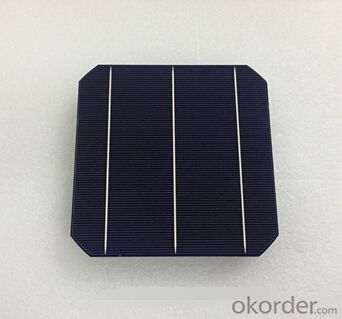
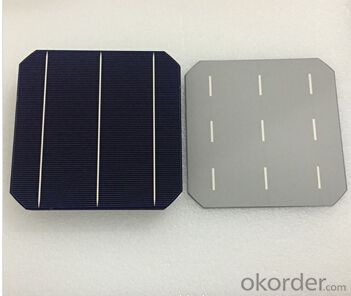
FAQ
We have organized several common questions for our clients,may help you sincerely:
①What price for each watt?
It depends on the efficiency of the solar cell, quantity, delivery date and payment terms.
②How long can we receive the product after purchase?
In the purchase of product within three working days, We will arrange the factory delivery as soon as possible. The pecific time of receiving is related to the state and position of customers.Commonly 7 to 10 working days can be served.
③Can you provide the peripheral products of the solar panels, such as the battery, controller, and inverter? If so, can you tell me how do they match each other?
Yes, we can, we have two companies for solar region, one is CNBM International, the other is CNBM engineering Co.
We can provide you not only the solar module but also the off grid solar system, we can also provide you service with on grid plant.
④What is your warranty of solar cell?
Our product can promise lower than 0.3% open box crack, we support claim after opening the box if it has crackm color difference or sth, the buyer should give pictures immediately, we can not accept the claim after the solar cell has assembled to solar panel.
• Timeliness of delivery
• ⑤How do you pack your products?
We have rich experience on how to pack the solar cell to make sure the safety on shipment, we could use wooden box or pallet as buyer's preference.
⑥ Can you do OEM for us?
Yes, we can.
- Q: How do solar cells handle hail or other physical damage?
- Solar cells are designed to be durable and can generally handle hail or other physical damage to a certain extent. Most solar panels are made with tempered glass or other strong materials that can withstand small hailstones without significant damage. However, severe hailstorms with large hailstones may cause cracks or breakage in the solar cells, affecting their efficiency. In such cases, it is important to assess the extent of the damage and consider repairs or replacements if necessary.
- Q: How do solar cells perform in areas with high levels of light pollution?
- Solar cells do not perform optimally in areas with high levels of light pollution as the excess artificial light can interfere with their ability to absorb sunlight and convert it into electricity. The presence of light pollution reduces the efficiency of solar cells and hampers their overall performance.
- Q: What is the role of monitoring systems in solar cell systems?
- The role of monitoring systems in solar cell systems is to track and analyze the performance of the solar panels, inverters, and other components. These systems provide real-time data on the energy production, efficiency, and potential issues or malfunctions. This allows for proactive maintenance, troubleshooting, and optimization of the solar cell system, ensuring maximum energy output and overall system reliability.
- Q: What is the internal structure of solar panels
- Crystalline silicon solar cells, the cost of equipment is relatively low, but the cost of consumption and battery sheet is high, but the photoelectric conversion efficiency is also high, in the outdoor sun power generation more suitable for thin film solar cells, the relative cost of equipment, but the cost of consumption and battery
- Q: What are the short-circuit currents of solar cells affected by the factors?
- Silicon cell: the life of the minority after the diffusion, silicon impurity content, silicon chip resistivity, cashmere suede, PE anti-reflective film anti-reflective effect, the front gate line printing and so on affect the short-circuit current.
- Q: I have a turnkey solar power project starting in 6 months, now we are searching the market in south China to find the best solar cells manufacturers. Any professional suggestion or recommendation?
- In south China, you will have more resources than in north China, because there are many solar cell factories over there, which means you get to have more choice to select from.
- Q: Can solar cells be used in powering RVs and campers?
- Yes, solar cells can definitely be used to power RVs and campers. In fact, many RVs and campers are now equipped with solar panels to generate electricity for various appliances and systems onboard. Solar power provides a sustainable and environmentally-friendly option for off-grid living, allowing RV and camper owners to have a constant source of clean energy while being able to travel and explore remote locations without relying solely on traditional power sources.
- Q: How do solar cells handle shading or obstructions?
- Solar cells are designed to handle shading or obstructions by using bypass diodes. These diodes allow the current to bypass the shaded or obstructed area, ensuring that the remaining unshaded cells can still generate electricity. This helps minimize the impact of shading or obstructions on the overall performance of the solar panel.
- Q: What is the role of charge controllers in solar cell systems?
- The role of charge controllers in solar cell systems is to regulate and manage the flow of electricity between the solar panels and the batteries. They prevent overcharging and deep discharge of the batteries, ensuring their longevity and maximizing their efficiency. Additionally, charge controllers protect the solar panels from damage caused by excessive voltage or current.
- Q: How does a solar cell raise industrial efficiency?
- Solar Cell Efficiency refers to the portion of energy in the form of sunlight that can be converted via photovoltaics into another more useful form, namely electricity.
Send your message to us
Bio Solar Cells - Monocrystalline Solar Cells A Grade 18.2%
- Loading Port:
- Shanghai
- Payment Terms:
- TT OR LC
- Min Order Qty:
- 5000 pc
- Supply Capability:
- 800000 pc/month
OKorder Service Pledge
OKorder Financial Service
Similar products
Hot products
Hot Searches
Related keywords
